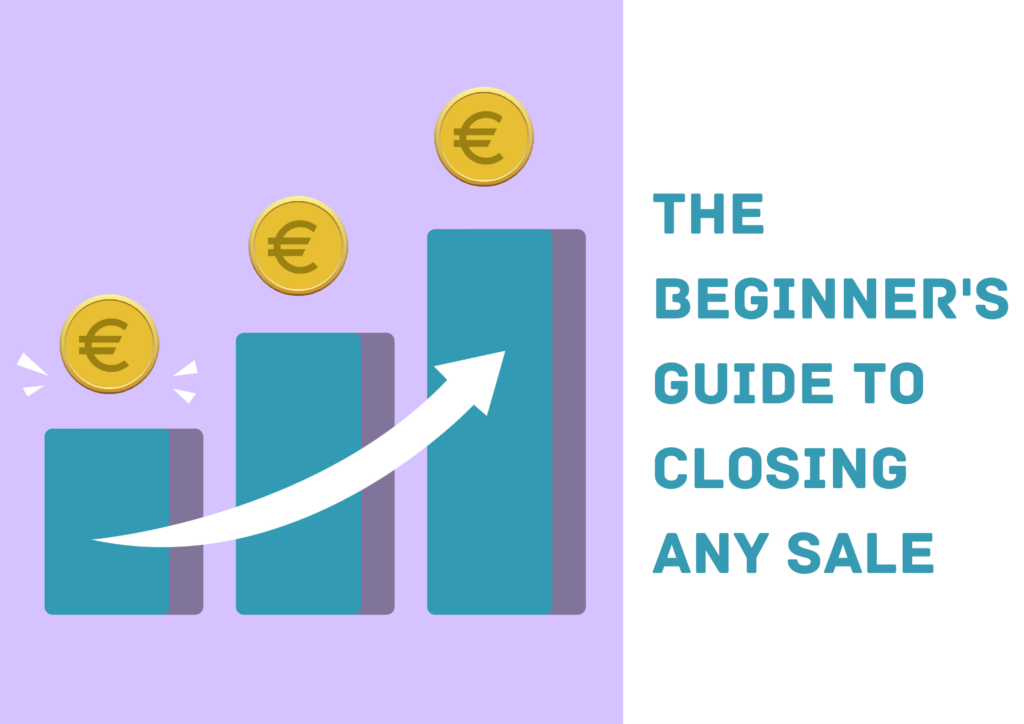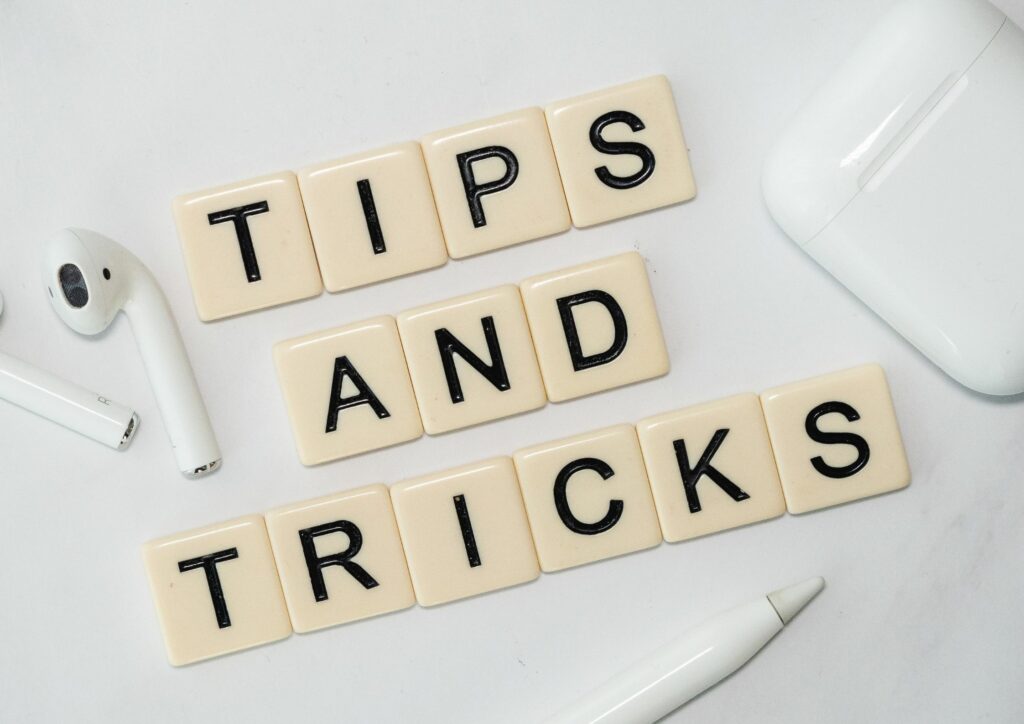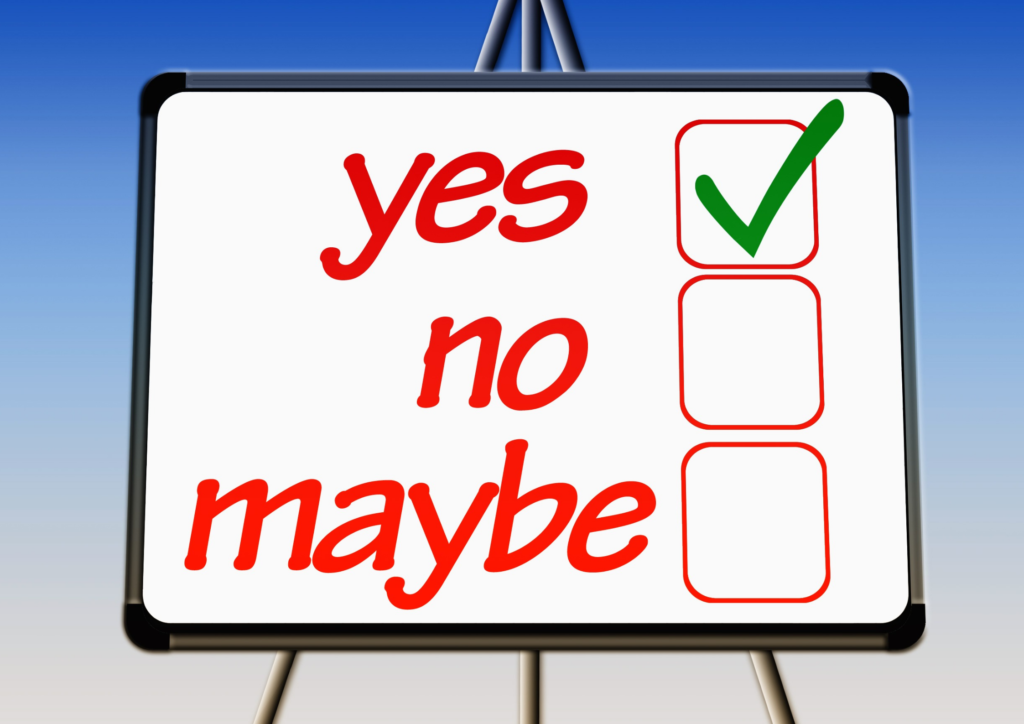INTRODUCTION
The salesperson and the consumer are constantly in a fascinating ballet when it comes to closing a deal. The dance passes by fast if the music is good, and everyone feels exhilarated and satisfied that they came to the club. If you choose the incorrect music, the dance will become one of those awful slow songs from a junior high school dance, when both sides are eager for the song to change so they can move on to a better possibility. Here are three ideas for making every sale simple so that everyone leaves the dance floor satisfied.
We present to you, the ultimate guide to closing every sale. Keep reading to learn more!
STEPS TO CLOSE THE SALE
Step 1:
Rather than trying to present a large list of benefits, concentrate on the aspects you believe are game-changers:
You can wax poetic about your fantastic product for hours, but the basic reality is that your consumer is short on both time and patience. Sure, she wants to know what your product accomplishes, but she also wants to be convinced that it is the one she requires. That is to say, the capabilities of your product are only significant in terms of how those capabilities will alter in her life. If your product is a stroller, and you tell me it comes in ten great colours, has a removable lining, and 360 swivel wheels, as a new mom, I’m going to buy it. I could nod and keep looking at my possibilities. When you explain that this means I can pick a colour that will keep my kid cool in the summer, wash the detachable liner when he spits up on it, and wheel him about town on suspension that rivals that of a BMW, you’ll get a lot quicker “YES.”
Step 2:
Contrast and compare your product to the competition’s:
Are you frightened of mentioning competitor items in your conversations with potential consumers because you think it will offer them a reason and a roadmap to go somewhere else? Don’t be that way. Consider the stroller once again. When I informed a sales professional that I had seen a model I wanted at another store and that his store didn’t have it, he was surprised.
He inquired about the one I’d seen and swiftly pointed out the difference between the one he was showing me and the one I’d seen elsewhere: his was two pounds lighter. He knew it would be a no-brainer for me to say yes to the notion of “less trash to carry” as a Manhattan mom on the move (and at the mercy of public transit!). Openly discussing various options with the consumer gives her the confidence to pick your goods in the end. It demonstrates that you are informed not only about your products but also about the industry as a whole, and it allays the customer’s fears that she might do better in another store or with a different product.
Step 3:
Provide price in a meaningful way. When it comes to money, no one likes a mystery:
It’s critical to communicate not only the price, but also the return on investment a consumer might expect when acquiring your goods. Returning to the stroller. The salesman also admitted that his stroller was $100 more costly than the one I was contemplating at the other store. “But I think you will discover that eliminating those extra 2 lbs of weight is well worth the price difference—especially as your kid develops and becomes bigger,” he continued before sticker shock hit in. By eliminating doctor’s appointments for an extra $100, you’ll save a lot more than that.” I paid the additional money, despite the fact that it was more than I had planned to spend, and I quietly thanked the salesperson every time I descended a flight of steps into the metro.
HOW TO MAKE A SALE: THE SCIENCE
Because salespeople are expected to achieve the highest possible win rates for their efforts, a variety of closing sales strategies have evolved throughout time which provide a scientific method to close a sale.
Let’s look at a sales number that’s quite insightful:
Sales statistics bear testimony to the fact that closing a sale is no piece of cake. After hearing “no” four times, 92 percent of salespeople say they give up on a prospect. In contrast, 80 percent of prospects claim to have said “no” four times before eventually saying “yes.”
Did you understand what I said?
Before changing their views and deciding to try out a new solution, the vast majority of individuals (80%) give a sales rep at least four “no’s.” On the other hand, nearly all salesmen (92 percent) never make it that far. This isn’t even taking into consideration how many sales teams and entrepreneurs spend their whole careers in the risky sales zone, never receiving a firm answer from their prospects!
This figure doesn’t suggest that every lead is only four “no’s” away from becoming a “yes,” but it does show that selling is a lengthy game, and the majority of potential customers won’t make a decision on your first cold call.
You’ll soar above the great majority of the competitors just by committing to follow up with leads, creating a connection, and staying in touch with your top prospects (those who stand to profit the most from your solution).
All of the tools in the world won’t help you make a deal unless you have a step-by-step procedure to follow and rely on—one that has been modified and polished through time.
SALES CLOSING TECHNIQUES: BEST WAYS TO SEAL THE DEAL
There are several proven ways you may use to close a transaction with a prospect. Here are several examples:
A) Closing Techniques in Traditional Sales
Traditional sales closing strategies typically use psychological tricks to offer that final push. Two of the most prevalent are listed below:
1. It’s Now or Never
When salespeople make an offer that contains a specific advantage, the customer is more likely to buy right away. Consider the following scenario:
- “At this price, this is the final one.”
- “For clients who join up today, we’re offering a 20% discount.”
- “I can move you to the front of the implementation line if you agree to buy immediately.”
This strategy works because it generates a feeling of urgency, which can assist overcome inertia when a prospect wants to buy but is unable to do so for whatever reason. Of course, before giving a discount or promotion, you should always demonstrate value.
2. The End of the Summary
In order to convince the prospect to sign, salespeople that utilise this closing method repeat the goods the client is hoping to buy (emphasising the value and advantages).
Consider the following scenario:
- “As a result, we offer the Centrifab washing machine with brushless motor, a 10-year full warranty, and free delivery and installation. When is the best time to deliver?”
You’re helping prospects picture what they’re getting out of the sale by condensing previously agreed-upon elements into one stunning bundle.
3. Closes at a Sharp Angle
Prospects frequently request price discounts or add-ons because they recognise that they have the upper hand — and that you anticipate it. If your sales manager has given you permission, use the acute angle close method to catch these prospects off guard.
B) Sales Closing Techniques of Today
These pre-programmed closure strategies are perhaps a bit out of date. Perhaps you find them a touch too “salesy,” especially with the surge of inbound sales.
The term “close” should be used to refer to any and all incremental agreements reached during the sales process, not simply at the point of final purchase.
In a sales meeting, agents should try to:
- Identify the customer’s needs
- Effectively describe how certain items or services meet those demands in a reasonable and satisfying manner.
There should be no obstacles to closure if these two prerequisites are met appropriately. At that moment, the concluding question can be asked directly.
Remember to keep track of all the information you get at this point in a free CRM. While the information may not appear immediately beneficial, keeping note of a prospect’s objections can help you improve your organisation and complete more transactions in the long term.
4. The question is finished.
Reps must ask probing inquiries to prospects in order to attain these two fundamental aims. As soon as a conversation with a prospect begins, effective salespeople focus on completing the deal. They generate desire in the customer and remove all objections to purchasing through a sequence of queries.
A question can even be used to complete the transaction, allowing the salesperson to answer any remaining issues while also getting a commitment.
“Does what I’m presenting, in your perspective, fix your problem?” for example.
The query helps you to find out if the prospect is interested in your goods while still leaving the door open for more sales.
If they say no, it’s still their opinion (not necessarily the reality), so you may keep selling. If you answered yes, the following step is to sign on the dotted line.
Here’s another one to consider: “Is there any reason why the cargo can’t go ahead?”
This query seeks closure or further information on why the customer isn’t persuaded. It’s a win-win situation.
5. Assumptive Closes
The power of positive thought is used in this closure approach. If you feel you will complete this business from the first email outreach, it may have a huge impact on the remainder of the sales process.
It’s critical to keep a careful eye on your prospect’s interest, involvement, and objections throughout the process. “Did this presentation fulfil your expectations?” ask after a call or meeting. If you’ve just given them fresh information about your product or service, you could want to ask, “Is this something you think your organisation might benefit from? Is there a specific need or pain point that this addresses?”
By keeping your ear to the ground and assuming good intent from the outset, you’ll give your sales process power and direction that it wouldn’t have otherwise.
6. The Take-Out Window Is Closing
If you have children, you’ve probably seen that taking a toy away from them makes them desire it even more. On your prospects, use a similar psychological technique.
If they object to the price, eliminate a feature or service and provide them with the cheaper offer. It’s more probable that they’ll remember the portion you took away than the lower price.
7. Close the Suggestion
Another ‘hard close’ technique, you share your viewpoint on what might work best in this conversation. Make solid assertions like “a Friday shipment would fix that difficulty” or “if you sign a contract by [date], your onboarding would be well before quarter end.”
Why does this work? Your viewpoint, like facts, penetrates their minds, and you provide concrete solutions to some of their difficulties.
When it’s most effective: When you have a strong (personal) relationship with your prospect or believe they’re readily swayed.
When not to utilize it: If you don’t know your lead very well, or if they are a field specialist who knows more than you do.
8. The Backwards Close
Although this strategy goes against virtually all sales training, it has been proven to work with specific sorts of prospects. Instead of trying to sell anything to your lead at the beginning of the connection, start at the conclusion and ask for recommendations.
Why does this work? The potential consumer will feel more at ease and receptive to listening to what you have to say if they realise you aren’t attempting to sell them something.
When it works best: When you know the individual, have their contact information via a referral, or already know they aren’t interested in what you’re offering.
When not to utilise it: Early in the sales cycle, when you have no cause to question your ability to close the deal.
Let’s speak about developing and altering these sales formulae in a way that works for your business now that you know the best strategies for closing sales, you’ve mastered the fundamental approaches, and you know when to utilise them.
9. Closing Softly
The soft close is a technique for showing your prospect the value of your product and then asking a low-impact inquiry to see if they’re interested in learning more.
“Would you like to learn more if I could cut widget maintenance by 25% and boost widget productivity by 15%?” for example.
You’ve explained the benefits clearly without making any demands or unexpected requests.
If the preceding scenario is still too direct, you may ask, “Would it line with your corporate goals if I told you I could cut widget maintenance by 25% and boost widget productivity by 15%?”
This eliminates their need to commit in any way to you, giving you more time to learn about them.
10. Financial Close
When you’ve successfully helped a prospect assess the effect of their business difficulties, a financial closure is the logical next step. A purchase choice is easier to defend if the measurable effect of company problems outweighs the expenditure necessary to fix the difficulties. The greater the gap between the measurable impact and the needed expenditure, the more easily the sale may be closed.
11. Time Line Close
When a product or service will have an influence on a prospect’s project plan, especially if the purchase decision is a requirement to subsequent project activities, the Time Line close is effective. If you start with the planned project completion date and work backwards through project milestones to the point when your company’s product or service should be included, you and the prospect will almost always find that an order should have been placed long ago!
12. Sympathy Close
Since the beginning of time, people have used this method to locate homes for puppies. “Why don’t you take the puppy home with you and see how you get along?” Bring the dog back if it doesn’t work out for you.” Yeah, really — how often do you suppose those adorable little puppies are returned?
If giving prospects the chance to try out your product or service converts them into adoring fans, you should do everything you can to make sure that (qualified) prospects have that chance. In many circumstances, prying your goods or service from their cold, dead fingers will be the only way to get it back once they’ve started using it. Cha-ching!
13. The Visual Close
Regardless matter how appealing the prospective return on investment is, some prospects have difficulty making a purchase choice. The Visual Close can be highly useful for these folks. Drawing a vertical line along the middle of a piece of paper, as well as a horizontal line that crosses the top of the vertical line, is required for this Close. On the paper, this results in a huge “T.” You should write the word “For” on the left side of the “T.” You should write the word “Against” on the right side of the “T.”
Now you should recommend to the prospect that they produce a list of all the reasons why they should buy your company’s product or service, both positive and negative. Assist the prospect in compiling the biggest list of items possible in the “For” field. Prospects should be permitted to fill in the “Against” section on their own for the most part.
The only exception is if an issue is regularly raised, in which case you should note it in the “Against” column ahead of time… and then do everything you can to remedy it right now! The normal outcome is that the “For” column’s list of arguments is substantially longer than the “Against” column’s list of reasons. Visualizing the difference might assist a hesitant prospect get over the decision-making hurdle.
14. The Close Thermometer
You ask a prospect to assess their degree of interest on a zero-to-ten scale in the Thermometer Close. A score of zero indicates that the prospect is uninterested, while a score of 10 indicates that they have already chosen to purchase.
You’re done if the prospect says “Ten.” Put down the phone and jot down the prospect’s order!
“Based on what you’ve told me so far, I don’t understand why you say that,” you should question if the prospect’s answer is five or lower (score). “Could you just explain it to me?” The prospect’s response will reveal what you need to do to move the sales cycle forward.
You ask a prospect to assess their degree of interest on a zero-to-ten scale in the Thermometer Close. A score of zero indicates that the prospect is uninterested, while a score of 10 indicates that they have already chosen to purchase.
You’re done if the prospect says “Ten.” Put down the phone and jot down the prospect’s order!
“Based on what you’ve told me so far, I don’t understand why you say that,” you should question if the prospect’s answer is five or lower (score). “Could you just explain it to me?” The prospect’s response will reveal what you need to do to move the sales cycle forward.
“What do you need to see to go to ten?” you should ask if the prospect’s answer is a six or above. The prospect’s response will once again inform you what you need to accomplish.
One of the benefits of the Thermometer Close is that it may be used several times. You may keep asking, “What do you need to see to get to ten?” as the prospect’s “temperature” rises. This is a wonderful, non-threatening method to persuade prospects to open up about problems that are blocking you from closing deals.
C) Techniques for Negotiation:
15. Maintain a neutral attitude.
Nothing is more damaging to your career chances than sensing anxiousness or impatience in you. So, even if you’re in a rush, focus on nailing your sales pitch and ignoring the pressure.
16. Don’t get irritated
Remember that your consumers may only require your product/service if they are unaware of all the specifics. It’s understandable that you’re irritated, but don’t take it personally. Always keep your feelings to yourself. Keep your professional demeanour and you’ll be able to seal the transaction.
17. Accept your client’s point of view.
It’s a highly efficient sales approach for interacting with others. The voice is a potent persuasive weapon. To acquire your consumers’ respect, change your tone, adapt your speaking tempo, and change the strength of your voice. You’ll be able to persuade them and keep their attention throughout the talk if you do it this way.
18. Concentrate your remarks on your client.
When the topic starts to spiral out of control, the most important thing to do is refocus the subject back to the customer. Try to figure out how he or she like to interact with your prospect. This should help to break the ice. When someone expresses their problems, it is much simpler to promote your product/service as a solution.
Furthermore, if you want to maintain track of your client communications, you need invest in a CRM. You may obtain a demo of Effigy’s solutions by filling out the form below.
19. Transport your client
Simply ask your potential consumers what goals they are searching for. Inquire of them about their plans for the upcoming year or semester. You’ll be able to tailor your sales pitch to their requirements and instill trust in them, allowing you to close even the most resistant prospects.
20. Assume responsibility for the customer’s issue
It’s critical to understand how much prospects desire to remedy the problem that makes them uncomfortable before making a transaction. If the prospect has already provided you with his or her problem, the next stage is to determine whether or not the prospect is prepared to fix it. It is not a matter of whether or not this potential consumer is ready to acquire what you have to offer; it is a question of whether or not he or she wants to get out of this circumstance. You’ll know right away if the prospect is ready to employ your product/service to better his or her everyday life by putting them in this circumstance.
21. Take charge of things
When you’re trying to close a transaction, you may come across folks who are attempting to divert your attention away from your pitch. They have the ability to talk to you about something else, divert the discussion, interrupt you, or make you talk about yourself.
You might respectfully stop them with something like, “I completely understand you, but what if I finish talking about it fast so that we can speak about what you want?”
This should be sufficient to slow down their goals and turn the conversation in the direction you desire.
22. Don’t think you’re better than everyone else
It’s acceptable to take an authoritarian stance in the face of uncertain futures. However, phrases like “you are wrong” or “I will tell you the truth” communicate your dominance. And it has the potential to stymie your prospects. And put your sale in jeopardy.
It is, however, more beneficial to provide facts honestly and to be interested in your prospect’s perspective. Instead of stating, “Did you know that experts anticipate that sales process automation will triple in the next three years?” say, “Did you know that experts estimate that sales process automation will quadruple in the next three years?” “I’ve heard that sales process automation will triple in the next three years,” says the twist. Do you believe it will have an impact on your business?”
The distinction is that in the first case, you indicate that your prospect is less educated than you, but in the second case, you offer a fact and include the receiver.
TRICKS TO CLOSE A SALE
Top 10 Language Tactics to Help You Close Every Deal
The keys to completing sales are strikingly similar across all sectors. Because generating sales is all about connecting with people, it’s not surprising that the keys are similar regardless of what you’re selling. People will be more likely to buy into whatever you’re offering if you say the correct words in the appropriate way.
There are a few linguistic strategies that may help you close every transaction, so think about these suggestions for talking to your potential purchasers before your next sale:
1. Reiterate your request for approval and ask for it again
After you’ve rehashed the idea, ask the customer whether they’re okay with moving forward. Use your best judgement in framing this, allowing the client to express any further concerns or objections if you believe they exist. “Unless you have any last concerns, I believe we are ready to get started,” for example, giving the customer the opportunity to ask any further questions without feeling rushed through the process.
2. Make a note of the client’s name:
Making a personal connection entails this step as well. When making a sale, you need to connect with the person you’re speaking with, and it’s difficult to do so if you never say their name. Remember and use their name to show that you are interested in them. Don’t go overboard – you don’t want to come out as obnoxious or weird – but mention his or her name sometimes throughout the talk.
3. Create an environment conducive to a sale
You’ll need to assist someone consider why buying your product or service would benefit them, and pictures can help. Draw a picture of the advantages they’ll get from using what you’re offering. Involve their emotions by comparing the decision to past excellent decisions and pleasant outcomes they’ve had when they’ve said yes in other situations.
4. Speak in plain English
You, as the expert, know a lot more about what you’re selling than your customers do. You may have far more information than they require or desire. If you try to impress your clients by burying them in facts and statistics to show you know what you’re talking about, you’ll most likely lose them in your explanations and technical jargon – and lose the sale. Keep what you’re saying basic, but not too simple. Don’t brag about your extensive knowledge or large vocabulary. Find short yet accurate methods to communicate the advantages of your product. To assist your clients in making the connections, relate your products or services to items they are familiar with. A cascade of knowledge will not help you gain more trust than speaking simply and directly.
5. Have a good time
Jokes and light-hearted anecdotes, on the other hand, might assist potential clients feel more at ease and relaxed, leading to more openness and eagerness to seal a transaction.
6. Overcome Their Disappointment
You’ll face challenging inquiries, objections to specific features, pushback on pricing, and a variety of other sales challenges on your way to completing any deal.
Some of the most typical objections you’ll encounter are:
- I don’t have the time • I’m short on cash
- Your stuff is overpriced.
- Please provide me further information by email; we don’t need it right now. […as well as a few industry-specific issues/questions]
Before making a sales call, you’ll need excellent solutions to these arguments.
Anticipating and dealing with objections is an inevitable aspect of the sales process, but it demands appropriate planning ahead of time—otherwise, you’re gambling with your offer.
When you improvise and try to respond to your prospect’s arguments on the spot without a solid basis, the quality of your response will be significantly influenced by your current mental state.
Furthermore, you risk seeming as if you have no idea what you’re talking about, which is a bad scenario for a salesperson to be in.
If you’re on a sales call with a prospect and they’re definitely interested in your product, but when it comes to price, they say it’s too expensive, you may say one of the following things:”
- I see what you mean. What’s more, I recently had two additional buyers who were confused about the pricing at first, just like you. But what they discovered was… “
- If you’re looking for a “Is that true? If it’s okay with you, could you tell me how you came to the opinion that the product is too expensive?”
- “Does the pricing point represent a cash flow or budget issue?”
• “Let’s look at some innovative ways to incorporate this into your budget.”
• If you’re looking for a “Okay, I get it. Is there a component of the product that you don’t require?”
All of these responses to the general pricing issue will delve into the various underlying causes for the argument’s emergence.
To prepare for every key sales objection in your industry, make a list of all the most typical objections you’ll encounter. Write down succinct responses to them, receive input from others on your team until they feel confident enough to approach them in a discussion, and practise the responses until you know them by heart.
In addition, make a list of any arguments that your prospects raise that you weren’t expecting and prepare replies for future prospects. If one person brought them up to you, there’s a good probability someone else will in the future.
7. Make a selling request.
Perfecting how (and when) you ask the question “are you ready to buy?” is at the heart of how to close a transaction in sales, and sure, you’ll have to get used to asking it. “The worst mistake salespeople and entrepreneurs can make is not asking for the sale,” Steli Efti regularly says while giving speeches and sales trainings throughout the world.
On the surface, this seems self-evident, right? So, why does this happen so regularly in the realm of sales?
It’s easy to believe that if you’re not a naturally gifted salesperson—and haven’t gone through the proper sales training to prepare yourself for success in this field—your prospects will come knocking on your door to hand over their credit cards after seeing all the benefits and features you have to offer.
However, this is a widespread misunderstanding among sales newbies, and anyone who has ever closed a transaction knows that this is rarely the case (if ever). Even aggressively selling salespeople frequently wait too long to ask for the sale, and as a result, they miss out on possibilities to close more transactions.
How much do you enjoy being rejected? I’m guessing not very much.
Because we’re hard-wired to dread rejection, it’s tempting to want to prevent the chance of rejection. Even in a sales setting, sales rejection is difficult to deal with, so we typically wait until we have a sure yes before asking if they’re ready to buy.
Instead, many people’s natural response is to supply more information and reasons to buy, thinking that they’ll finally close. So, when is it OK to ask for a sale? Before you believe they’re ready, is the solution.
Ask for the sale if you’ve done your job qualifying your prospect, making your presentation, and still feel they’d be a good fit for using your product.
Expect most prospects to say no at first, but factor this into your selling strategy. When you catch a prospect off surprise and you’re both on the same page about the value they’re getting, they won’t have a good excuse not to buy right now.
Say something like, “Hey, it appears like you two are a good match.” I’ve demonstrated how we’ll successfully tackle your challenges. “Are you prepared to make a purchase?” As we previously stated, they’ll most likely say no at this stage, but that’s fine. “What’s the procedure we need to go through in order to make you ready to buy?” immediately follow up on their no. This demonstrates to your prospect that you are not afraid of rejection, that you are confident, and that you are prepared to work with them to get to a point where saying yes makes sense. Always remember that completing a transaction is a two-way discussion.
Furthermore, whatever complaints they may have been concealing will arise instantly, allowing you to fling forth your perfectly planned responses to their arguments. If you still can’t close, you might be able to obtain the deal by asking a few more questions.
8. Request a second time
Even if a customer has previously declined, finding new methods to inquire can help you complete deals. This isn’t the same as asking, “Do you want to buy my product?” in a direct or forthright manner. It implies coming back around and negotiating from a different angle, introducing more information or casting the sale in a different light, and then asking the customer if they are still interested.
9. Be Honest
Nobody wants to believe they’re being duped or that they’re unimportant. Warmth and honesty are crucial factors in closing transactions. You have a better chance of closing a transaction if clients feel you genuinely care about their requirements and interests.
They have no motive to buy from you if they feel you don’t care about them and are only interested in selling them anything. Even if they need what you’re offering, if you don’t convey a caring attitude, they won’t want to buy it from you. Take a real interest in the individuals you’re selling to, and be truthful in your comments, and you’ll sell more.
10. Maintain a positive attitude and smile
Finally, you must have a cheerful attitude no matter what you say. Negativity isn’t going to help you sell anything. If the customer is pessimistic, adding your pessimism will only make the situation worse. Remember the ancient adage, “Honey attracts more flies than vinegar attracts.”
Even if they are suspicious or unfavourable at first, being optimistic might help you win them over. One of the most important ways to transmit this happiness to others is to smile. Practice saying anything with a grin, including disagreeing with a smile. It will calm folks down and show that your dispute isn’t personal and that it can be resolved. Smiles increase sales.
TO TURN A “NO” INTO A YES ,” ASK SALES CLOSING QUESTIONS
Depending on the sort of possible transaction you’re dealing with, the way you ask for the sale may change. To properly quantify your lead earlier in the sales process, you might want to start with more broad B2B sales enquiries. If you’re close to closing, use these questions to get your prospect to explain why they’re hesitating, so you can guide them to the line of reasoning that will persuade them to say yes.
1. “What are all of the actions we need to take to help this transaction come together?”
2. “Are there any roadblocks that may prevent this deal from going through?”
3. “Do you believe our solution is a suitable fit for your needs based on what we’ve discussed?” Why?”
4. “When do you want to make a choice and start putting a plan in place?”
5. “Would you consider committing today if I could throw in [incentive]?”
6. “Can you tell me the ideal day and time for our next meeting?”
7. “Is there any reason you wouldn’t want to do business with us right now?”
8. Would you be willing to make this agreement happen next week if we could find a method to deal with [objection]?”
9. “After considering everything, I believe one of these two ideas would be the greatest fit for you.” “Would you want to take [X] or [Y]?”
10.”You stated that you want a solution by [X date]. I can assure you that we will have adequate time for training and execution if you sign up by [Y date]. What do you think about that?”
11. “Are you ready to take the next step?” Right now, I can email you the contract.”
12. “What do you believe would be a good next step in resolving your present issues?”
13. “Unless you have any other questions or concerns, I believe we are ready to begin.”
14. “Our product appears to be a good fit for you today, based on what you’ve mentioned. What are your thoughts?”
15. “How sure are you that our product will suit your demands on a scale of 1 to 10?”
FOR CLOSING SALES, MORE READING IS RECOMMENDED
1. How to Make Every Sale Work
SUMMARY IN ONE WORD: The essential method to effectively concluding any sales presentation from the world’s finest salesperson.
2. Zig Zigler’s Closing Sale Secrets
SUMMARY IN ONE WORD: To be successful, doctors, housewives, preachers, parents, teachers, and others must “sell” their ideas and themselves.
3. The Perfect Close:
The Secret To Closing Sales-Best Selling Practices & Techniques
SUMMARY IN ONE WORD: Read this book if you want to learn how to close sales using the best technique (one that is non-pushy, flexible, natural, and simple to learn).
4. Selling Psychology: The Art Of Closing Deals
SUMMARY IN A LINE: Discover The Keys To Sales Success!
With Brian Tracy’s “The Psychology of Selling!” you can achieve success.
PHASES THAT WILL ASSIST IN THE TRANSFORMATION OF A PROSPECT INTO A CLIENT
The key difference between the questions above and the sales phrases to help you close is that these don’t require your prospect to respond in a way that allows you to lead them to realise they want your product; these phrases are better used when you’re confident you’re close to making the sale and ready to ask for it.
Here are a few closing sales words to assist you obtain that final, solid “yes”:
- “Unless you have any other issues, I believe we can move through with the arrangements.”
- “Let’s talk about the expenses.”
- If you’re looking for a “This conversation is set to finish in [X] minutes. Please take as much time as you need, but if you’re ready, we should probably go on to the agreement.”
Are you ready to put [the product] into practise at your company?”
- “I can provide you [reward] if you commit to purchase now.”
- If you’re looking for a “This solution appears to be a good fit for you, but I realise you need a little more time. Let’s meet next week once you’ve had a chance to think about it a little more.”
- If you’re looking for a “It’s okay if you can’t commit right now. Unfortunately, this deal is only valid for [a certain length of time], therefore I’ll need a signed contract by [date] to keep this pricing.”
FINAL TAKEAWAYS FOR BETTER SALES CONVERSION
So, now that you’ve read this article and are a natural salesperson, what’s next? How can you convert all of your information about different sorts of sales closes into actual sales? Putting these great sales closing strategies into reality by trying them out is the best way to go. Return to some cold leads and use these sales closing methods to warm them up!
You’ll want to pick your interaction style carefully depending on your prospect’s unique characteristics. Always keep in mind that you’re working with actual people, and the less they seem like a generic lead follow-up, the more likely you are to close the purchase.
The more they resemble a standard lead follow-up, the more likely you are to close the deal.
Your ability to close a transaction fast and successfully is influenced by everything from your tone of voice to your ability to discern what your prospect is thinking. You’re wasting their time if you go on and on discussing product features your prospect plainly doesn’t care about, or if you spend ten minutes chatting about the weather. This puts you on the fast track to never hearing back after an initial conversation.
Carefully selecting your interaction style with your prospects is one of the most underrated and sometimes subconscious components of sales. Let’s take a look at a couple of them.
Hostile + Strong: Like the movie The Wolf of Wall Street, this tough-guy selling technique is all about doing and saying whatever it takes to persuade a prospect to buy your goods, regardless of whether or not they’d benefit from it.
Friendly + Strong: Be a member of your prospect’s team and approach them with the mindset that you’re here to assist them in finding the greatest answer to their difficulties. When you feel your product is the greatest option, you’ll stick to your guns and don’t give in to offers of discounts left and right, but if your product isn’t the perfect match, you’ll help them find something that is.
Weak + hostile: The most ineffective marketing approach, which mixes negative energy and mindset with a readiness to travel in any way the wind is blowing on any given day. To say the least, this isn’t the attitude you want to use when attempting to clinch a deal.
Friendly + Weak: You’ll earn a few points for being friendly, but you risk being viewed as overly nice at the end of the day if you use this selling method (even a pushover). When the time comes, don’t be afraid to ask for the sale, and don’t make significant compromises just to maintain the customer.
If you reside in the friendly and strong zone, your excitement will rub off on others (yes, even during video demos and phone calls with prospects—hoorah, inside sales). Your prospects will sense your confidence, which will improve their faith in you when paired with being polite (rather than overconfident). In a relationship, nothing is more appealing than trust and confidence.
Now go out and close some sales with your newfound sales closing skills!















